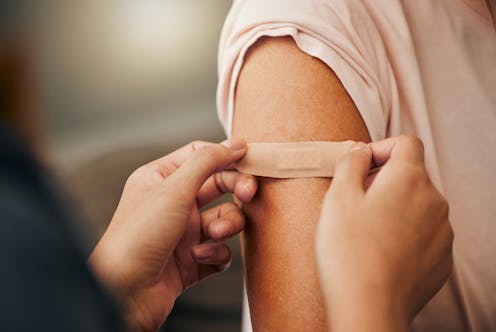Flu vaccines are now available for 2025. What’s on offer and which one should I get?
- Written by Allen Cheng, Professor of Infectious Diseases, Monash University

It’s that time of year when flu vaccines are becoming available in Australia. You may have received an email from your GP clinic or a text message from your pharmacy telling you they’re in stock.
So far in 2025 in Australia, there have been more flu notifications compared to the same period in previous years.
Elsewhere, many northern hemisphere countries have reported intense flu activity during the 2024–25 winter season. This has included several deaths in children.
Although it’s difficult to make predictions about the intensity and timing of the upcoming flu season, it’s a good time to start thinking about vaccination.
Who should get vaccinated, and when?
In Australia, flu vaccines are available for everyone over the age of six months. Flu vaccines don’t work well in young infants, but they can be protected if their mothers are immunised during pregnancy.
The National Immunisation Program provides free vaccines for people at higher risk, including specific age groups (adults older than 65 and children between six months and five years), those with chronic medical conditions, pregnant women and Aboriginal and Torres Strait Islander people.
For healthy adults and children outside these groups, a flu vaccine costs around A$20–30. The vaccines are widely available at GPs and pharmacies, and through workplace programs.
Flu vaccines reduce the risk of GP presentation with influenza by around 30–60% and hospitalisation with influenza by about 50–70%.
There’s some evidence the protection from flu vaccines wanes over several months. Ideally, everyone would get vaccinated within a few months of the peak of the flu season. But in reality, we can’t easily predict when this will occur, and since the COVID pandemic, flu seasons have arrived unusually early in the year. So, some time in the next month or so is a good time to get vaccinated.
In general, flu vaccines can be given at the same time as most other vaccines, including COVID vaccines, but check with your vaccination provider about whether this is appropriate for you.
Influenza vaccines are regarded as safe. While some people may get a sore arm or fever, these symptoms are usually mild and short lived. Serious side effects, such as Guillain-Barré syndrome, are rare, and are thought to be less common than after influenza infection.
Why do we need a flu vaccine every year?
Influenza is a difficult virus to make vaccines for, as the virus changes frequently, and vaccines generally only provide protection against a limited range of strains. Some studies suggest mutations in the influenza virus are 20 times more common than with SARS-CoV-2, the virus that causes COVID.
This means, each year, experts need to predict the likely circulating strains in the next season, so vaccines can be manufactured in preparation.
The World Health Organization coordinates two meetings each year – in February to decide on vaccine strains for the following northern hemisphere season, and around September for the southern hemisphere.
Although all current influenza vaccines contain strains from four influenza subtypes (A/H1N1, A/H3N2, B Victoria and B Yamagata), one of the strains appears to have disappeared during the pandemic. So next year’s vaccines will probably drop the B Yamagata strain.
Seasonal flu vaccines don’t provide protection against avian influenza (bird flu) strains, but vaccination is still recommended for people who may be at risk of bird flu, such as poultry workers. This is to reduce the chance that a new virus could result from the combination of both seasonal and avian influenza strains.
Which vaccines are available?
There are a variety of vaccines you may be offered when you book in or turn up for a flu vaccine.
Over the past few years, new types of vaccines have been developed. Some of these attempt to improve the body’s immune response to vaccines. For example, Fluad Quad contains an adjuvant called MF59, an additional substance designed to attract immune cells to the site of vaccination.
Other vaccines, such as Fluzone High-Dose, use a larger dose of the vaccine strains to improve the immune response. These vaccines are recommended for older people, as immune responses tend to decline with age.
Certain vaccines use alternative production methods to try to improve the match between vaccine strains and the circulating strains. Standard flu vaccines are produced using influenza viruses grown in chicken eggs. One weakness of this method is that viral mutations can occur during the production process, known as “egg adaptation”. During some of the seasons between 2014 and 2019, this was shown to reduce the effectiveness of flu vaccines.
The avoid this issue, cell-based vaccines, such as Flucelvax Quad, use influenza vaccine strains grown in mammalian cells rather than eggs.
The key takeaways are:
older people are recommended to receive an enhanced vaccine (Fluad Quad for >65 years or Fluzone High-Dose for >60 years), with Fluad Quad provided free under the National Immunisation Program
other people are recommended to receive a standard vaccine (egg-based or cell-based), with vaccines provided free for high-risk groups and children between six months and five years.
Looking to the future
There are several new flu vaccines currently under development. Recombinant vaccines, such as Flublok, use insect cells to produce a specific component of the virus.
With the success of mRNA vaccines for COVID, there is interest in using a similar process for influenza. In theory, this could shorten the time to develop vaccines, for both seasonal influenza and pandemic influenza.
There’s also interest in combination vaccines – for example, a single shot could provide protection against both COVID and the flu.
The “holy grail” of influenza vaccines is one that could provide long-lasting protection against many different strains. Although we’re not there yet, you’re at lower risk of influenza and its complications if you get a flu shot.
Authors: Allen Cheng, Professor of Infectious Diseases, Monash University





